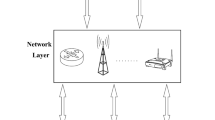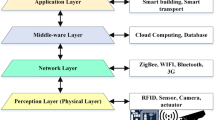Abstract
In wireless sensor networks, security is one of the most challenging issues. An attack against sensors or the intruder intervention in the zone of interest can deny the integrity of the exchanged data between the sensors and the base station. In this paper, we propose a technique of data integrity protection using a novel method of shared cryptography for wireless sensor networks. Our proposal considers a cluster-based network. Sensor nodes belonging to a cluster are supervised by a cluster-head. The latter aggregates securely the sensed data and transmits them to the base station. Before sending the sensed data to the cluster-head, the sensor nodes encrypt partially the message using a shared cryptography protocol. The cluster-head reconstitutes the message in order to authenticate the integrity of the transmitted data. We have developed simulations, in which the obtained results show the performances of our protocol in terms of communication overhead and energy consumption.







Similar content being viewed by others
References
Ammari, H. M. (2013). The art of wireless sensor networks: Fundamentals (Vol. 1). Berlin: Springer.
Akyildiz, I. F., & Vuran, M. C. (2010). Wireless sensor networks: Advanced texts in communications and networking (Vol. 4). New York: Wiley.
Zabin, F., Misra, S., Woungang, I., Rashvand, H. F., Ma, N. W., & Ali, M. A. (2008). REEP: Data-centric, energy-efficient and reliable routing protocol for wireless sensor networks. LET Communications, 2, 995–1008.
Prasad, N. R., & Alam, M. (2006). Security framework for wireless sensor networks. Journal of Wireless Personal Communications, 37, 455–469.
Venkatraman, K., Daniel, J. V., & Murugaboopathi, G. (2013). Various attacks in wireless sensor network: Survey. International Journal of Soft Computing and Engineering, 3(1), 208–211.
Merkle, R., & Hellman, M. (1978). Hiding information and signatures in trapdoor knapsacks. IEEE Transactions on Information Theory, 24(5), 525–530.
Li, J. F., Wei, D. W., & Kou, H. Z. (2008). Secure monitoring scheme based on identity-based threshold signcryption for wireless sensor networks. In Proceedings of the 4th wireless communications, networking and mobile computing (pp. 1–4). Dalian.
Cheng, X., Liu, J., & Wang, X. (2005). An identity-based signature and its threshold version. In Proceedings of 19th advanced information networking and applications (pp. 973–927). Taiwan.
Sliti, M., Hamdi, M., & Boudriga, N. (2008). An elliptic threshold signature framework for k-security in wireless sensor networks. In Proceedings of 15th electronics, circuits and systems (pp. 226–229). St. Julien’s.
Singh, K., & Sharma, L. (2013). Hierarchical group key management using threshold cryptography in wireless sensor networks. International Journal of Computer Applications, 63(4), 43–49.
Koschuch, M., Hudler, M., Kruger, M., Lory, P., & Wenzel, J. (2010). Applicability of multiparty computation schemes for wireless sensor networks. In Proceedings of the 2010 data communication networking (pp. 1–4). Athens.
Gennaro, R., Rabin, M. O., & Rabin, T. (1998). Simplified VSS and fast-track multiparty computations with applications to threshold cryptography. In Proceedings of the seventeenth annual ACM symposium on principles of distributed computing (pp. 101–111). USA.
Rivest, R., Shamir, A., & Adleman, L. (1978). A Method for obtaining digital signatures and public-key cryptosystems. In Proceedings of communications of the ACM (Vol. 21, No. 2, pp. 120–126). New York, USA.
Nokhanji, N., & Hanapi, Z. M. (2014). A survey on cluster-based routing Protocols in wireless sensor networks. Journal of Applied Sciences, 14(18), 2011–2022.
Gupta, S. K., Jain, N., & Sinha, P. (2013). Clustering protocols in wireless sensor networks: A survey. International Journal of Applied Information Systems, 5(2), 41–50.
Yuce, M. R., & Khan, J. (2011). Wireless body area networks: Technology, implementation, and applications. Boca Raton, FL: CRC Press.
Gupta, S. K., Mukherjee, T., & Venkatasubramanian, K. K. (2013). Body area networks: Safety, security, and sustainability. Cambridge, MA: Cambridge University Press.
Abdesslem, F. B., Ziviani, A., Dias de Amorim, M., & Todorova, P. (2007). Looking around first: Localized potential-based clustering in spontaneous networks. IEEE Communications Letters, 11(8), 653–655.
Odlyzko, A. M. (1994). Discrete logarithms and smooth polynomials. In G.-L. Mullen, & P.-J.-S. Shiue (Eds.), Finite fields: Theory, applications, and algorithms, contemporary mathematics. American Mathematical Society.
Heinzelman, W. R., Chandrakasan, A., & Balakrishnan, H. (2008). Energy-efficient communication protocol for wireless microsensor networks. In Proceedings of the 33rd Hawaii international conference on system sciences HICSS. IEEE Computer Society.
Acknowledgments
This work was carried out in the framework of research activities of the laboratory LIMED, which is affiliated to the Faculty of Exact Sciences of the University of Bejaia. It was done in collaboration with the Labex MS2T, which was funded by the French Government, through the program “Investments for the future” managed by the National Agency for Research (Reference ANR-11-IDEX-0004-02).
Author information
Authors and Affiliations
Corresponding author
Rights and permissions
About this article
Cite this article
Bouakkaz, F., Omar, M., Laib, S. et al. Lightweight Sharing Scheme for Data Integrity Protection in WSNs. Wireless Pers Commun 89, 211–226 (2016). https://doi.org/10.1007/s11277-016-3261-5
Published:
Issue Date:
DOI: https://doi.org/10.1007/s11277-016-3261-5




